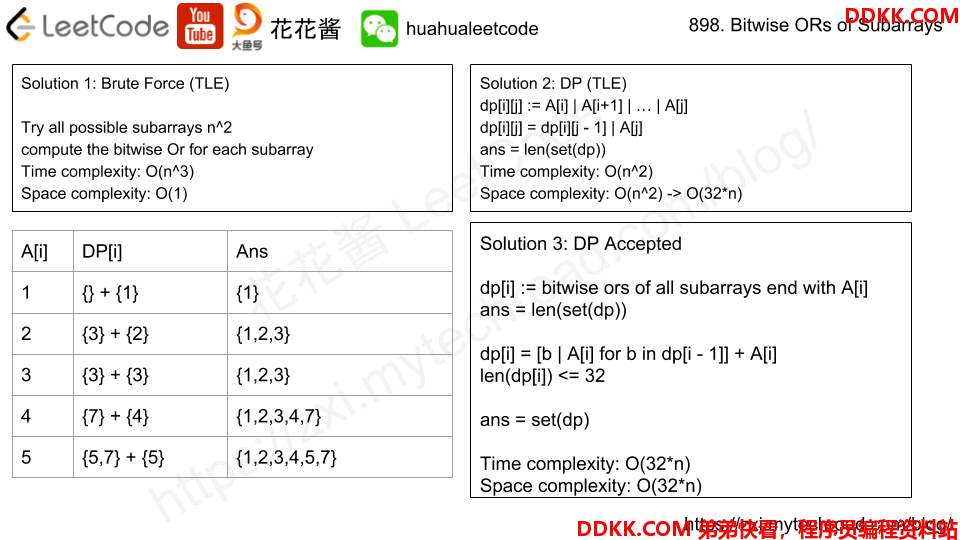题目地址:https://leetcode.com/problems/bitwise-ors-of-subarrays/description/
题目描述
Wehave an array A of non-negative integers.
Forevery (contiguous) subarray B = [A[i], A[i+1], ..., A[j]] (with i <= j), we take the bitwise OR of all the elements in B, obtaining a result A[i] | A[i+1] | ... | A[j].
Return the number of possible results. (Results that occur more than once are only counted once in the final answer.)
Example 1:
Input: [0]
Output: 1
Explanation:
There is only one possible result: 0.
Example 2:
Input: [1,1,2]
Output: 3
Explanation:
The possible subarrays are [1], [1], [2], [1, 1], [1, 2], [1, 1, 2].
These yield the results 1, 1, 2, 1, 3, 3.
There are 3 unique values, so the answer is 3.
Example 3:
Input: [1,2,4]
Output: 6
Explanation:
The possible results are 1, 2, 3, 4, 6, and 7.
Note:
1、1<=A.length<=50000;
2、0<=A[i]<=10^9;
题目大意
一个数组的所有子数组的异或结果,总共有多少个不同?
解题方法
动态规划
题目不是一般的难啊,如果是普通的DP方法,那么使用二维dp[i][j]表示子数组的起始和结束区间,能做到O(n^2)的时间复杂度,但是题目对时间复杂度要求的很死,必须O(N).
正确的做法也是动态规划,dp[i]表示以A[i]结尾的所有子数组的异或结果,其实是个set。
转移方程式dp[i] = [b | A[i] for b in dp[i - 1]] + A[i],即以A[i]结尾的所有子数组异或结果等于以A[i-1]结尾的所有子数组异或结果,和当前的A[i]异或,再加上A[i]这个结果。
同时使用一个set保存所有的异或结果。最后返回这个结果set的长度。

dp[i]的大小至多是32个,即 |dp[i]| <= 32 的证明:
dp[i] = {A[i], A[i] | A[i - 1], A[i] | A[i - 1] | A[i - 2], ... , A[i] | A[i - 1] | ... | A[0]},这个序列单调递增,通过把A[i]中的0变成1。A[i]最多有32个0。所以这个集合的大小 <= 32。
举例:最坏情况 A = [8, 4, 2, 1, 0] 都是2^k。 A[5] = 0,dp[5] = {0, 0 | 1, 0 | 1 | 2, 0 | 1 | 2 | 4, 0 | 1 | 2 | 4 | 8} = {0, 1, 3, 7, 15}.
时间复杂度是O(32*N),空间复杂度是O(32N).
class Solution(object):
def subarrayBitwiseORs(self, A):
"""
:type A: List[int]
:rtype: int
"""
res = set()
cur = set()
for a in A:
cur = {n | a for n in cur} | {a}
res |= cur
return len(res)
1 2 3 4 5 6 7 8 9 10 11 12
相似题目
参考资料
https://zxi.mytechroad.com/blog/dynamic-programming/leetcode-898-bitwise-ors-of-subarrays/
DDKK.COM 弟弟快看-教程,程序员编程资料站,版权归原作者所有
本文经作者:负雪明烛 授权发布,任何组织或个人未经作者授权不得转发